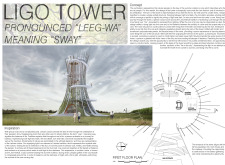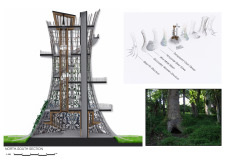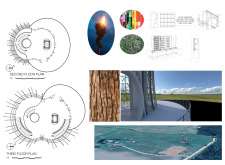5 key facts about this project
The architecture of Ligo Tower employs a central circular design that facilitates an efficient flow of movement while symbolizing the cyclical nature of life. The integration of diverse materials, such as steel, wood, and glass, provides both structural integrity and aesthetic warmth. The design prioritizes natural light, with strategically placed openings and transparent panels that enhance the interior experience and promote interaction with the surrounding landscape.
Unique Aspects of the Design Approach
One notable feature of the Ligo Tower is its celebration of Latvian cultural identity, using architecture to convey traditional narratives through contemporary design elements. The upper gathering space is specifically designed to function as a modern interpretation of a communal bonfire, a central aspect of the Jāņi festival. This design choice fosters a sense of communal experience, encouraging visitors to gather and engage with one another.
The use of materials also sets this project apart. The combination of a steel frame with a wooden secondary structure introduces a tactile element that resonates with the natural environment. The incorporation of wire metal mesh and polycarbonate panels provides transparency, allowing light to filter into the space while maintaining visual connections with the exterior. This thoughtful choice of materials not only enhances the sensory experience but also aligns with sustainable architectural practices.
Functional and Spatial Considerations
The Ligo Tower serves multiple functions, catering to visitors seeking both individual reflection and communal engagement. Each level of the tower is designed with specific activities in mind, from quiet contemplation areas to dynamic social spaces. The design maintains a connection to nature through its careful placement within the landscape, optimizing views and integrating the building into its surroundings.
Architectural elements such as the expansive windows and open staircases create a fluid transition between internal and external spaces, promoting a sense of openness. Each floor of the tower reflects principles of interaction, and the circular motif reinforces the idea of continuity and connection.
To gain deeper insights into the architectural plans, sections, and overall designs of Ligo Tower, readers are encouraged to explore the project presentation for comprehensive details on this culturally rich architectural endeavor.


























